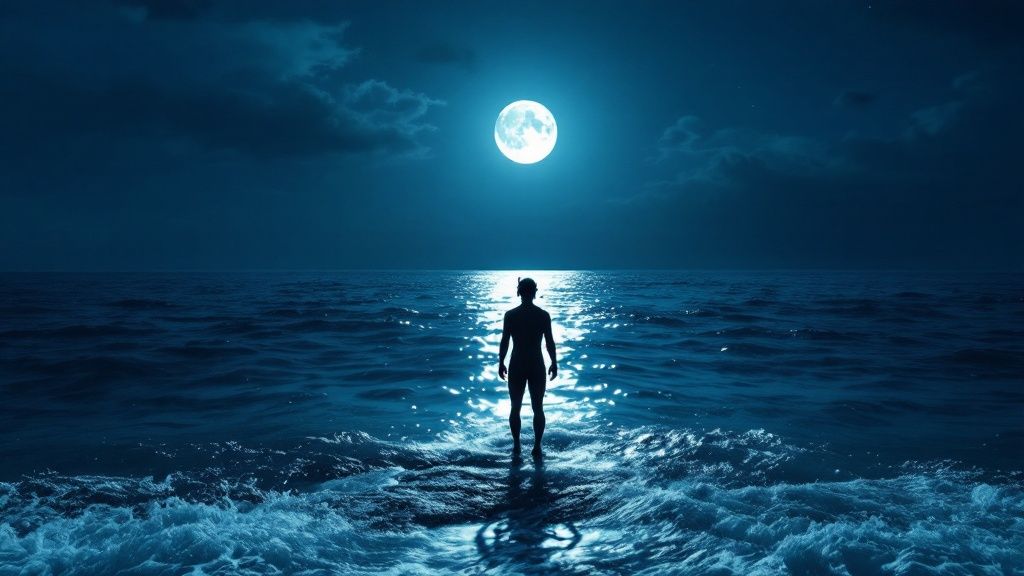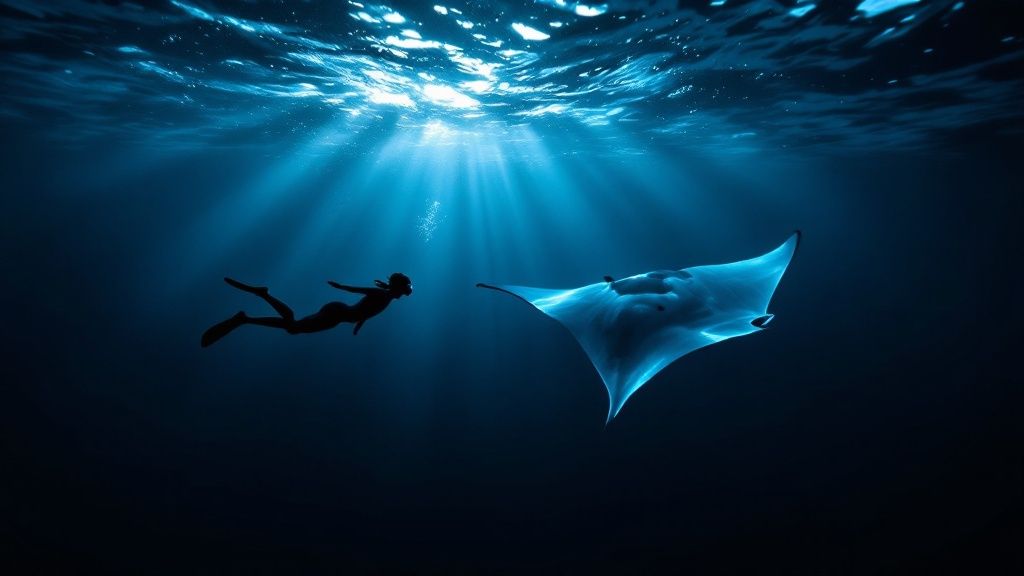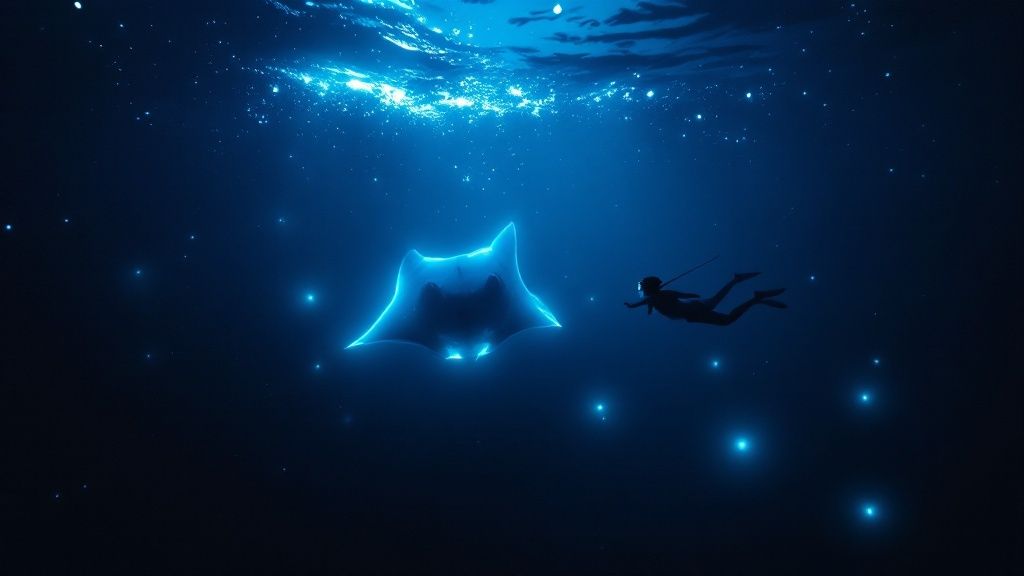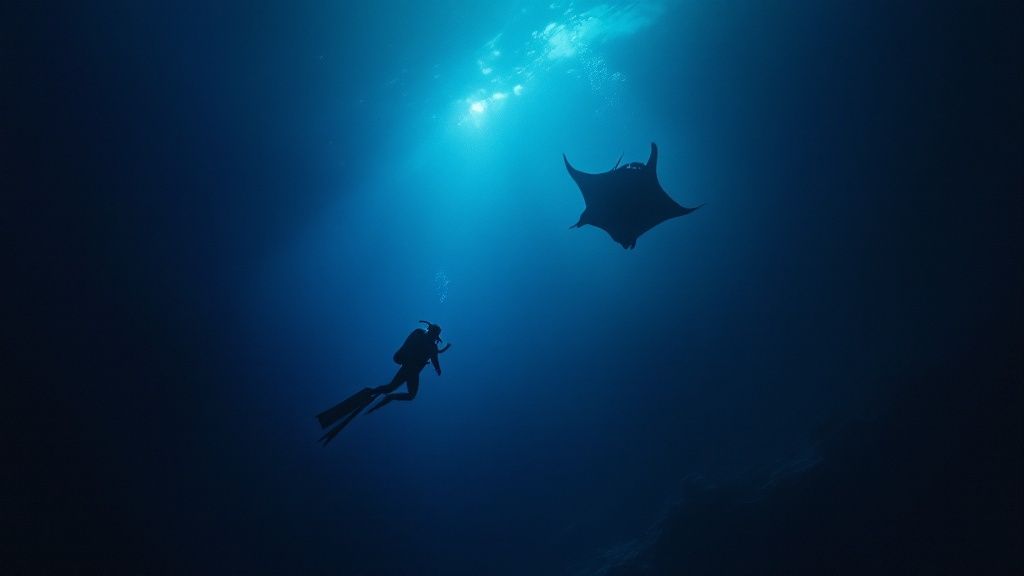Night Snorkeling with Manta Rays: A Hawaii Adventure
- Byron
- Mar 23
- 13 min read
The Magic of Night Snorkeling With Manta Rays

There's something truly special about entering the ocean at night. The darkness, illuminated only by the stars and the soft glow of dive lights, creates a sense of anticipation. This is especially true when you're hoping to encounter one of the ocean's most graceful creatures: the manta ray. Night snorkeling with manta rays is a unique and unforgettable experience, distinct from any daytime encounter.
The allure of this nighttime adventure lies in the combination of darkness, bioluminescence, and the manta rays' feeding habits. As daylight fades, a hidden world comes alive. Bioluminescent plankton, tiny organisms emitting their own light, create a breathtaking spectacle. The water transforms into a shimmering, living canvas, setting the perfect stage for the manta rays' arrival.
Attracted by the lights used by tour operators to draw in plankton, manta rays glide in from the depths. Their enormous wingspans, some reaching over 10 feet, cast impressive shadows in the illuminated water. These graceful creatures perform a mesmerizing underwater ballet as they feed.
Their slow, elegant movements, combined with the ethereal glow of the plankton, create an awe-inspiring display. The way they perform barrel rolls while feeding establishes a hypnotic rhythm, captivating all who witness it.
Why Hawaii is the Premier Destination
Hawaii's unique ecosystem is key to its status as a prime location for night snorkeling with manta rays. The warm, clear waters of the Kona Coast, rich in plankton, provide the ideal environment for these gentle giants to thrive. This creates a reliable and easily accessible location for these extraordinary encounters, making it a truly unforgettable experience.
This unique experience has made night snorkeling with manta rays on the Big Island of Hawaii incredibly popular. The shallow bays off the Kona Coast offer the ideal setting for these encounters. In fact, it has become a highly sought-after activity, with over 80,000 people participating annually. Find more detailed statistics here: Why Manta Ray Night Snorkels are so Popular. You might be interested in: More blog posts about manta rays.
Since 2020 legislation restricted dolphin interactions in Hawaii, many have sought alternative eco-friendly marine experiences. This surge in popularity highlights the growing demand for unique, eco-conscious travel. The sheer number of manta rays gathering in these bays is a testament to the richness of Hawaiian waters.
The Majestic Giants: Hawaii's Manta Ray Population

The magic of night snorkeling with manta rays is amplified by understanding these incredible animals. These graceful giants, often weighing as much as a small car, navigate the ocean with surprising agility. Their unique feeding habits make night viewing possible. As filter feeders, manta rays consume massive amounts of plankton. This reliance on plankton draws them to surface waters at night, attracted by the lights that also attract their microscopic food source.
Manta Ray Biology and Behavior
Manta rays exhibit captivating behaviors that enrich the observation experience. Barrel rolling, a feeding technique where they somersault through the water, is a frequent sight on night snorkeling tours. These graceful movements, often performed in groups, are a true spectacle. Their complex social interactions, sometimes described as underwater ballets, further add to the fascination. Want to learn more? Consider learning more about manta ray facts from our sitemap.
Two primary species of manta rays inhabit the waters off the Big Island: the reef manta ray (Mobula alfredi) and the giant manta ray (Mobula birostris). Despite their impressive size, with adults weighing up to 3,000 pounds, their diet consists primarily of plankton. Each manta ray possesses unique spot patterns on its belly, much like human fingerprints, used for identification. These majestic creatures also hold significant cultural value in Hawaii, appearing in ancient chants like the kumulipo. Discover more about Hawaiian manta rays.
Identifying Individual Mantas
Researchers can identify individual manta rays thanks to the unique spot patterns on their bellies. These ventral markings act like fingerprints, allowing marine biologists to track individual mantas. This tracking helps scientists understand their movement patterns, feeding habits, and social structures. This personalized identification transforms a general viewing into a connection with specific animals, creating a more meaningful experience.
Site Fidelity and Conservation
The concept of site fidelity adds another layer of wonder to these encounters. Some manta rays return to the same feeding areas for decades, showcasing a remarkable connection to those locations. This loyalty underscores the vital importance of conservation. Protecting these essential habitats guarantees that future generations can experience the magic of night snorkeling with manta rays. Understanding their behavior emphasizes responsible tourism and our shared role in preserving this remarkable experience.
Prime Locations: Where to Experience Manta Magic

Not all manta ray viewing locations are created equal. Choosing the right spot can significantly enhance your night snorkeling adventure. The Kona Coast, famous for its abundant manta ray populations, offers several key locations known for breathtaking encounters. Understanding each site's unique characteristics helps you choose the perfect setting for your underwater experience.
Makako Bay (Garden Eel Cove) vs. Keauhou Bay
Two popular locations for night snorkeling with manta rays are Makako Bay, also known as Garden Eel Cove, and Keauhou Bay. Each offers unique characteristics suited to different preferences. Makako Bay is known for its calmer waters, a great choice for those prone to seasickness or less confident swimmers. However, this can also mean larger crowds and more boats.
Keauhou Bay, being slightly more exposed to the open ocean, can sometimes experience stronger currents. This provides a more natural, wilder feel, potentially with fewer people. Deciding which environment best suits your comfort level is key to enjoying your experience.
The number of manta rays at each location varies depending on the season and other environmental factors. Both Makako Bay and Keauhou Bay have established "manta villages," areas with consistent planktonic activity that attracts the rays. These predictable feeding grounds enhance your chances of a memorable encounter.
To help you decide which location best suits your needs, we've compiled a comparison table highlighting the key features of each:
To help you choose the best spot for your manta ray adventure, take a look at this comparison:
Comparison of Top Manta Ray Viewing Sites A side-by-side comparison of the main manta ray night snorkeling locations on the Big Island, highlighting key differences to help readers choose the best option for their experience.
Location | Best For | Average Group Size | Typical Number of Mantas | Water Conditions | Accessibility |
|---|---|---|---|---|---|
Makako Bay (Garden Eel Cove) | Beginners, those sensitive to motion sickness | Larger (due to popularity) | Varies, often numerous | Calm, generally clear | Easy access from shore |
Keauhou Bay | More experienced snorkelers, those seeking a wilder experience | Smaller (potentially fewer boats) | Varies, can be abundant | Can have stronger currents, occasional stirred sediment | Easy access from shore |
This table summarizes the key differences between the two locations, allowing for a quick comparison to help you choose the best fit for your snorkeling adventure.
Water Conditions, Visibility, and Manta Behaviors
Water conditions significantly impact your night snorkeling experience. Visibility is crucial, and while both locations usually offer clear waters, factors like recent rain or plankton blooms can affect visibility. Keauhou Bay’s sometimes-stronger currents can occasionally stir up sediment, potentially reducing visibility. However, these currents also bring in fresh plankton, attracting more manta rays and increasing the chance to observe dynamic feeding.
Manta ray behaviors can also differ. In calmer waters, expect to see graceful gliding and circling. In areas with more current, you might observe more active feeding behaviors, including impressive barrel rolls. Understanding these nuances helps you choose your preferred type of encounter.
Exploring Lesser-Known Viewing Spots
While Makako Bay and Keauhou Bay remain popular, less-trafficked alternatives offer similar encounter quality with fewer crowds. Exploring these hidden gems offers a more intimate experience. These locations may require a slightly longer boat ride, but the reward is a sense of discovery and solitude.
As of 2015, at least 42 commercial tour operators offered night snorkeling and diving experiences at Makako Bay and Keauhou Bay. On busy nights, there can be up to 28 boats and over 170 people in the water. This highlights the importance of choosing reputable tour operators who prioritize safety and sustainable practices. For more information, see this report on Manta Ray Viewing Operations.
Choosing the right location is essential for an unforgettable manta ray night snorkel. Factors like water conditions, accessibility, and crowd levels significantly influence your experience. By considering these factors and exploring beyond the most popular spots, you can create a truly magical experience. Learn more about manta ray night snorkeling. The thrill of witnessing these gentle giants combined with the unique ambiance of a nighttime ocean is an experience you won't soon forget.
Preparing For Your Underwater Night Adventure

A night snorkel with manta rays is an exciting experience, but it's normal to feel a bit of pre-trip anxiety. This guide offers practical tips from experienced guides and manta ray enthusiasts to help you prepare and make the most of this incredible adventure. Turn those nerves into anticipation with a little planning!
Choosing The Right Tour Operator
Choosing a reputable tour operator is the first step toward a safe and memorable experience. Look for operators dedicated to sustainable tourism and small group sizes. This approach minimizes the impact on the manta rays and provides a more personal encounter. Before you book, ask some key questions:
What safety protocols are in place?
What is their manta ray sighting success rate?
Is all the necessary equipment provided?
What is the guide-to-snorkeler ratio?
Do they offer wetsuits?
These questions will help you assess the operator's professionalism and commitment to quality. Reading reviews and testimonials from previous participants can also give you valuable insights.
What To Expect From Departure To Return
Most night snorkeling tours follow a similar pattern. After check-in, you'll receive a briefing on manta ray biology and behavior. A short boat ride will then take you to the snorkeling site. Once there, you'll enter the water with your guide and gather around a specially lit float that attracts plankton, which in turn attracts the manta rays.
You'll likely spend about 20-30 minutes snorkeling with the manta rays, depending on the tour operator and manta ray activity. After the snorkel, you'll return to the boat and head back to shore. The whole experience typically lasts 1.5 to 2 hours. Jack's Diving Locker, a well-known operator, reports an 85-90% manta ray sighting rate. Of course, as with any wildlife encounter, sightings aren't guaranteed and can be affected by weather and ocean conditions. Swells over 6 feet or wind speeds exceeding 15 mph can impact visibility and the overall experience. Even so, the chance to snorkel with manta rays continues to draw adventurers from all over the world to the Big Island. For more specific data, see the Jack's Diving Locker Manta Ray Report.
Essential Personal Items and Gear
Packing the right items will ensure a comfortable and enjoyable night snorkel.
Warm Layers: Even in Hawaii, evenings can be cool, especially after being in the water. Pack a light sweater or jacket for the boat ride back.
Towel and Change of Clothes: You’ll want to dry off and change into something warm after your snorkel.
Personal Snorkel Gear (Optional): Most operators provide gear, but bringing your own mask and snorkel guarantees a good fit.
Motion Sickness Remedies: If you're prone to seasickness, consider medication or acupressure bands.
Underwater Camera: Capture the magic with a waterproof camera or GoPro, making sure it’s securely attached to a float or wrist strap.
For additional tips and guidance, check out our guide on how to master night snorkeling with manta rays.
Staying Relaxed in Dark Waters
Entering dark water can be unnerving for some. Prepare yourself mentally by focusing on slow, deep breaths to manage any anxiety and promote relaxation. Talk to your guide about any concerns you have; they are experienced in helping first-time night snorkelers feel at ease. Remember, you can always view the manta rays from the boat if you prefer.
Family Considerations
Night snorkeling with manta rays is a great family activity. Children as young as five are often welcome, but discuss their comfort levels with water and darkness beforehand. Ensure they understand the importance of following the guide's instructions and staying calm in the water.
Seasonal Timing and Ocean Conditions
While manta rays are present year-round, the best time for night snorkeling is typically during the drier months (April-October) when the water tends to be calmer and clearer. Even during peak season, weather conditions can change, so always be prepared for possible adjustments to your plans.
Understanding Manta Behavior: The Science of Encounters
Experiencing a night snorkel with manta rays becomes even more magical when you understand the science behind these gentle giants. Why do these magnificent creatures, some with wingspans over 10 feet, congregate in these specific locations at night? Their fascinating adaptations and unique feeding strategy make nighttime dining the perfect choice.
The Evolutionary Adaptations of Night Feeders
Manta rays are incredibly efficient filter feeders. They consume massive quantities of plankton, tiny organisms drifting in ocean currents. Their huge mouths and specialized gill rakers allow them to filter these microscopic creatures from the water. This feeding strategy requires them to find areas with high plankton concentrations, often found near the surface at night.
The Allure of Artificial Light: A Plankton Buffet
The artificial lights used by tour operators are key to attracting plankton. These tiny organisms are naturally drawn to light, creating a perfect feeding ground for the manta rays. This reliable food source makes these locations irresistible to the rays, offering a unique opportunity for close encounters during night snorkeling.
Decoding Manta Ray Behavior: Barrel Rolls and Feeding Formations
Watching manta rays feed is a captivating spectacle. Their iconic barrel rolls, where they somersault through the water while filtering plankton, are a common sight. This behavior maximizes their feeding efficiency, allowing them to consume large amounts of plankton concentrated in a specific area. You might also see unique feeding formations where multiple mantas work together to create a swirling vortex that concentrates plankton.
For years, extensive research on manta ray behavior has been conducted on the Kona Coast. From 2009 to 2014, underwater videographers diligently documented manta ray sightings at spots like 'Manta Village' and 'Manta Heaven.' Learn more: Manta Ray Statistics. This data allowed researchers to track individual manta rays, monitor their health, and predict sighting hotspots.
To help you plan your manta ray adventure, we've compiled sighting probabilities by season:
Manta Ray Sighting Probability by Season
Season | Sighting Probability | Average Number of Mantas | Water Conditions | Notes |
|---|---|---|---|---|
Spring | High (80-90%) | 10-15 | Calm, clear | Peak season |
Summer | High (70-80%) | 8-12 | Warm, clear | Popular season |
Fall | Moderate (50-60%) | 5-8 | Variable, can be rougher | Fewer tourists |
Winter | Moderate (40-50%) | 3-5 | Cooler, can be rough | Least crowded |
This table provides a general overview, and actual sighting rates can vary.
These long-term studies revealed valuable insights into manta ray movements, site fidelity, and the impact of seasonal changes on their behavior, ultimately contributing to better conservation strategies.
Research, Tracking, and the Future of Manta Encounters
Identifying individual manta rays by their unique ventral markings, similar to fingerprints, has transformed research. These markings allow scientists to track individual rays over time, providing valuable insights into their life history and behavior. These long-term studies help researchers understand social structures, migration patterns, and site fidelity. This knowledge is crucial for developing effective conservation strategies to protect these magnificent creatures and ensure these magical night snorkeling encounters continue for years to come. Ongoing research emphasizes the connection between responsible tourism and conservation efforts, ensuring these gentle giants remain a vibrant part of the Hawaiian ecosystem.
Maximizing Your Manta Ray Experience
There's a profound difference between simply glimpsing a manta ray and truly connecting with these magnificent creatures. This section, drawing on insights from underwater photographers, marine naturalists, and seasoned guides, will help you elevate your night snorkeling with manta rays experience. We'll explore strategic positioning for unforgettable close-up views, effective underwater camera techniques in challenging low-light conditions, and respectful body language for a harmonious encounter with these gentle giants.
Positioning for the Perfect View
Think of a dinner buffet – you wouldn't want to be stuck in the corner, missing all the action. The same principle applies to manta ray viewing. Strategic positioning during your night snorkel maximizes your chances of a truly memorable encounter. Most tours utilize lights to attract plankton, the manta ray's primary food source. Position yourself near the light source, but not directly beneath it. This allows you to observe the mantas as they gracefully glide through the illuminated water, often performing captivating barrel rolls and intricate feeding formations. Avoid sudden movements, which can startle these sensitive creatures. Instead, maintain a calm presence and let the mantas approach you on their terms.
Mastering Low-Light Underwater Photography
Capturing the magic of a night snorkel with manta rays presents unique photographic challenges. The low-light conditions require specific camera settings and techniques. Increase your ISO and utilize a wide aperture to maximize light capture. A fast shutter speed is essential to freeze the manta rays' movements, especially during their dynamic feeding displays. For GoPro or similar action cameras, a red filter can enhance colors and reduce the blue cast common in underwater night photography. And don’t forget a secure wrist strap or float – losing your camera in the dark would be a real disappointment.
Respectful Interactions: Body Language and Etiquette
Manta rays are gentle giants, deserving of our utmost respect. Certain body language cues can foster a more harmonious interaction. Never reach out to touch the mantas. This can disrupt their delicate mucous layer, which plays a vital role in their immune system. Maintain a respectful distance, allowing the mantas to dictate the encounter. Avoid excessive splashing or sudden movements, which can easily startle them. Cultivate a calm and observant posture, remembering you are a guest in their underwater world. This respectful approach will enrich your experience immeasurably.
Extending Your Comfort and Observation Skills
Feeling comfortable and relaxed in the water enhances your ability to truly observe and appreciate the manta rays. Slow, deep breaths can help manage any anxiety and promote relaxation, particularly for those new to night snorkeling. If you begin to feel cold, gently treading water can generate some warmth. Practicing breath-hold techniques before your snorkel will maximize your underwater viewing time. Learning to identify individual mantas by their unique ventral markings adds another layer of depth to the experience, transforming a general viewing into a personalized encounter. These simple practices can make a significant difference in your overall experience, turning a standard tour into a truly enriching connection with these magnificent ocean travelers.
Conservation Matters: Protecting Manta Magic
Night snorkeling with manta rays is an unforgettable experience. It's important to remember that this adventure takes place within a fragile ecosystem. Responsible tourism plays a key role in protecting these gentle giants and ensuring these encounters remain viable for years to come. This means understanding how even seemingly small actions can significantly impact manta ray populations.
How Regulations Protect Mantas and Swimmers
Current regulations around manta ray night snorkeling evolved to protect both the animals and the people observing them. Limiting the number of boats and snorkelers minimizes disruptions to the manta rays' natural feeding. Guidelines about maintaining a safe distance and avoiding touching the mantas prevent disease transmission and protect their delicate mucous layer. These rules aren't arbitrary; they're based on years of research and observation by marine biologists and conservationists. Check out our sitemap for additional details.
Supporting Local Conservation Efforts
Several local organizations dedicate their work to manta ray conservation. They conduct vital research on manta ray populations, advocate for stronger protections, and educate the public about responsible tourism. You can support them through donations, volunteering, or simply by raising awareness. Even small contributions matter. For instance, choosing tour operators committed to sustainable practices helps ensure your experience benefits these magnificent creatures.
The Positive Impact of Responsible Tourism
Responsible tourism can be a powerful force for positive change. Revenue from manta ray night snorkeling tours often directly funds research and conservation work. These tours also raise public awareness about the importance of protecting manta rays and their habitat. This increased awareness can lead to greater support for conservation and help ensure these gentle giants' long-term survival. However, it’s crucial to remember that our actions during these tours directly affect the mantas.
Practical Steps for Conservation-Minded Snorkelers
Here are some practical steps you can take to minimize your impact and contribute to manta ray conservation:
Choose reputable tour operators dedicated to sustainable practices.
Follow all guidelines provided by your guides regarding safe distances and manta ray interactions.
Use reef-safe sunscreen to avoid water pollution.
Consider supporting local conservation organizations through donations or volunteering.
By taking these simple steps, you can ensure your manta ray night snorkeling adventure is both unforgettable and beneficial to these amazing animals. Ready for an unforgettable adventure that supports manta ray conservation? Book your Manta Ray Night Snorkel Kona Hawaii Tour today! Experience the magic of these gentle giants knowing your visit contributes to their protection. Choose from sunset or after-dark tours, suited for all ages and experience levels.
Comments